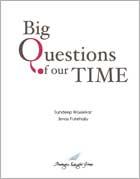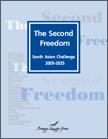Asia, Europe and Unity of Vision
 |
June, 2009
By Sundeep Waslekar
|
When I began my career as a young researcher a little over two decades ago, I concentrated on South Asian Regional Cooperation. I had the privilege to attend the Second SAARC Summit in Bangalore, which was an exhilarating experience for someone who had just started a research career. I met Pakistan�€™s Foreign Secretary at the Summit. He invited me to Pakistan as an official guest at a time when India-Pakistan relations were cold and there was hardly any exchange of people.
I was soon asked to serve on an expert committee on regional cooperation. Kant Bhargava of India, second Secretary General of SAARC and his successor, Ibrahim Hussein Zaki of the Maldives, were deeply committed to SAARC. Along with Farooq Sobhan, a senior Bangladeshi diplomat, they created a circle of professionals to promote linkages within the region. I was included in this circle and had significant insights into the institutional aspects of the SAARC process.
My commitment to South Asian cooperation was thus a combined result of genuine belief in the concept and the tremendous personal opportunity offered to me by the leading lights of that time. As a student of SAARC, I was also watching other regional cooperation processes. Around that time, the European Economic Community was transformed into the European Union.
Some 15-20 years later, the European Union has progressed to have a Parliament, a common Schengen Visa, and Euro. Moreover, Europe has expanded from the original six members of the Common Market to the present 27 of the Union. It is expected to expand even further. When some of the European governments attempted competitive financial policies in the wake of the current economic meltdown, immediately voices to save Europe were expressed strongly across the continent.
During the same period, SAARC has been reduced to summits (not quite annual any longer), bureaucratic meetings, a tariff reduction agreement that nobody knows of and a proposal to create a regional university. It is extremely difficult for the Indians and Pakistanis to obtain Visas. The regional discourse is dominated by terrorism and conflict. The only occasion when India and Pakistan cooperated whole heartedly in recent years was when they both supplied arms to Sri Lanka to crush LTTE and then protected the Sri Lankan government from investigations for war crimes in a UN forum. The only expansion of SAARC has been to include Afghanistan. Individual SAARC members have linkages with ASAEAN, China and the East Asian nations but there has been no institutional effort to create an Asian Union. Oddly SAARC has introduced a fashionable arrangement to invite observers ranging from Australia to the United States, and perhaps Mauritius in the near future.
However, the differences in institutional evolution are superficial. Europe�€™s real union is psychological. More and more Germans, French, Swedes, Czechs, Dutch, Portuguese, Hungarians feel that they are Europeans. The European Union is essentially a union of values. The Chinese, Japanese, Koreans, Indians, Malaysians, Indonesians, Pakistanis, Vietnamese, are committed to the nation state. A regional union can at best be a free trade area. Asian regional cooperation arrangements are essentially bureaucratic exercises.
The results can be seen in two critical aspects of life that matter to common people. The Europeans are a lot wealthier and more peaceful than they were 25 years ago �€“ especially ask the Spaniards and the Irish. There has been no conflict between members of the European Union once they became members. The standard of living has gone up for all those who joined the Union either formally or those closely integrated with it informally (Norway and Switzerland). On the other hand, despite nice brochures of investment bankers, most Asian countries have at least half of their population living miserable lives. There is tension between Japan and China, India and Pakistan, North and South Korea. Several countries are subjected to terrorist attacks, from within and sometimes with support from neighbouring countries. At least two Asian countries �€“ Pakistan and North Korea �€“ are considered potential threats to global stability.
In their failure to create a union of values, the Asians are squandering away an opportunity to rise. Only three to four hundred years ago, Asia accounted for half of the world�€™s manufacturing, trading and overall economic output. The Asians do well in Europe and the United States. If they are not able to bring prosperity to close to 100 percent population and free themselves from the fear of war and terror, it is because they have failed to inculcate strong values. There is a lot they can learn from Europe. On the other hand, Europe can benefit from Asia�€™s inherent dynamism, the ability of Asian youth to work hard, and its strong cultural foundation, which though corroded by corruption and efficiency of the last few decades, has tremendous potential to contribute to the advancement of human civilization.
Asia and Europe have ignored each other, except in commercial deals and institutional processes. Their interaction has been superficial and formal. It has no soul. It has no passion. It is the performance of a musician who is thinking of a possible contract at the end of the show. It is about time that the concerned people in the two continents make joint efforts to discover spirit in their relationship and create a common vision �€“ not only for themselves but also for their joint contribution to shape the world in the twenty first century.
Related Publications
-
.jpg&maxw=50)
Big Questions of Our time: The World Speaks, 2016
Download:Big Questions of Our time: The World Speaks _Full Report
-

-

Second Freedom South Asian Challenge 2005-2025, 2005
read more
Download:Second Freedom South Asian Challenge 2005-2025 Full Report
Related latest News
Related Conferences Reports
-

Global Challenges Conference, October 2016
Download:Global Challenges Conference Report
-

Conference on Responsibility to the Future: Business, Peace and Sustainability, June, 2008
Download:Global Security and Economy: Emerging Issues


